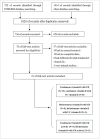Association between 25(OH)D Level, Ultraviolet Exposure, Geographical Location, and Inflammatory Bowel Disease Activity: A Systematic Review and Meta-Analysis
- PMID: 26172950
- PMCID: PMC4501705
- DOI: 10.1371/journal.pone.0132036
Association between 25(OH)D Level, Ultraviolet Exposure, Geographical Location, and Inflammatory Bowel Disease Activity: A Systematic Review and Meta-Analysis
Abstract
Background: There is no consensus on the vitamin D levels and inflammatory bowel disease (IBD).
Aim: To conduct a systematic review and meta-analysis to analyze the relationship between IBD and 25(OH)D, sun exposure, and latitude, and to determine whether vitamin D deficiency affects the severity of IBD.
Methods: We searched the PubMed, EBSCO, and ClinicalTrials.gov databases to identify all studies that assessed the association between 25(OH)D, sun exposure, latitude, and IBD through November 1, 2014, without language restrictions. Studies that compared 25(OH)D levels between IBD patients and controls were selected for inclusion in the meta-analysis. We calculated pooled standardized mean differences (SMDs) and odds ratios (ORs).
Results: Thirteen case-control studies investigating CD and 25(OH)D levels were included, and eight studies part of above studies also investigated the relationship between UC and 25(OH)D. Both CD patients (SMD: 0.26 nmol/L, 95% confidence interval [CI]: 0.09-0.42 nmol/L) and UC patients (SMD: 0.5 nmol/L, 95% CI: 0.15-0.85 nmol/L) had lower levels of 25(OH)D than controls. In addition, CD patients and UC patients were 1.95 times (OR, 1.95; 95% CI, 1.48-2.57) and 2.02 times (OR, 2.02; 95% CI, 1.13-3.60) more likely to be 25(OH)D deficient than controls. We also included 10 studies investigating the relationship between CD activity and vitamin D. Results showed that patients with active CD (CD Activity Index ≥ 150) were more likely to have low vitamin D levels. In addition, whether low sun exposure and high latitude were related to a high morbidity of CD need to be provided more evidence.
Conclusion: Our study shows that IBD patients have lower vitamin D levels. For active CD patients, vitamin D levels were low. These findings suggest that vitamin D may play an important role in the development of IBD, although a direct association could not be determined in our study.
Conflict of interest statement
Figures






Similar articles
-
Vitamin D for the treatment of inflammatory bowel disease.Cochrane Database Syst Rev. 2023 Oct 2;10(10):CD011806. doi: 10.1002/14651858.CD011806.pub2. Cochrane Database Syst Rev. 2023. PMID: 37781953 Free PMC article.
-
Effectiveness and safety of vitamin D in relation to bone health.Evid Rep Technol Assess (Full Rep). 2007 Aug;(158):1-235. Evid Rep Technol Assess (Full Rep). 2007. PMID: 18088161 Free PMC article.
-
Patient education interventions for the management of inflammatory bowel disease.Cochrane Database Syst Rev. 2023 May 4;5(5):CD013854. doi: 10.1002/14651858.CD013854.pub2. Cochrane Database Syst Rev. 2023. PMID: 37172140 Free PMC article.
-
Interventions for the management of abdominal pain in Crohn's disease and inflammatory bowel disease.Cochrane Database Syst Rev. 2021 Nov 29;11(11):CD013531. doi: 10.1002/14651858.CD013531.pub2. Cochrane Database Syst Rev. 2021. PMID: 34844288 Free PMC article.
-
Systemic pharmacological treatments for chronic plaque psoriasis: a network meta-analysis.Cochrane Database Syst Rev. 2017 Dec 22;12(12):CD011535. doi: 10.1002/14651858.CD011535.pub2. Cochrane Database Syst Rev. 2017. Update in: Cochrane Database Syst Rev. 2020 Jan 9;1:CD011535. doi: 10.1002/14651858.CD011535.pub3. PMID: 29271481 Free PMC article. Updated.
Cited by
-
Skin Exposure to Narrow Band Ultraviolet (UVB) Light Modulates the Human Intestinal Microbiome.Front Microbiol. 2019 Oct 24;10:2410. doi: 10.3389/fmicb.2019.02410. eCollection 2019. Front Microbiol. 2019. PMID: 31708890 Free PMC article.
-
Diet, Sun, Physical Activity and Vitamin D Status in Children with Inflammatory Bowel Disease.Nutrients. 2022 Feb 28;14(5):1029. doi: 10.3390/nu14051029. Nutrients. 2022. PMID: 35268001 Free PMC article.
-
Serum Vitamins D, B9 and B12 in Greek Patients with Inflammatory Bowel Diseases.Nutrients. 2020 Dec 4;12(12):3734. doi: 10.3390/nu12123734. Nutrients. 2020. PMID: 33291539 Free PMC article.
-
Is there a relation between vitamin D, interleukin-17, and bone mineral density in patients with inflammatory bowel disease?Arch Med Sci. 2018 Sep 5;17(3):662-674. doi: 10.5114/aoms.2018.78009. eCollection 2021. Arch Med Sci. 2018. PMID: 34025836 Free PMC article.
-
The role of UVR and vitamin D on T cells and inflammatory bowel disease.Photochem Photobiol Sci. 2017 Mar 16;16(3):347-353. doi: 10.1039/c6pp00266h. Photochem Photobiol Sci. 2017. PMID: 27714313 Free PMC article. Review.
References
-
- Loftus EV Jr. Clinical epidemiology of inflammatory bowel disease: Incidence, prevalence, and environmental influences. Gastroenterology. 2004;126(6):1504–17. Epub 2004/05/29. . - PubMed
Publication types
MeSH terms
Substances
LinkOut - more resources
Full Text Sources
Other Literature Sources

